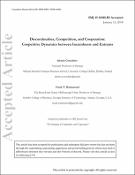Options
Discontinuities, competition, and cooperation: Coopetitive dynamics between incumbents and entrants
Author(s)
Date Issued
2018-12
Date Available
2018-11-26T12:29:28Z
Abstract
Research Summary: We advance an integrative model in which distinct types of technological discontinuities (core‐knowledge vs. complementary‐asset) are combined with different appropriability regimes (strong vs. weak) to predict competitive and cooperative dynamics between incumbents and entrants. We posit that incumbents ally with entrants following a core‐knowledge discontinuity when the appropriability regime is strong. When the appropriability regime is weak, incumbents are more likely to acquire entrants. We submit that the additional consideration of complementary‐asset discontinuities reveals a more integrated theoretical model of competition and cooperation between incumbents and entrants. In particular, incumbents tend to cooperate among themselves following complementary‐asset discontinuities, although we highlight theoretical nuances due to different appropriability regimes. We provide falsifiable propositions, and introduce contingencies such as firm‐level heterogeneity and time dynamics. --- Managerial Summary: Interfirm cooperation is one possible avenue for existing firms to address the challenge of responding to discontinuous technological changes. What is not clear, however, is who should the incumbent ally with: other incumbents or new entrants? We provide an integrative framework to help managers to decide when to cooperate with competitors and when to cooperate with new entrants. When the core knowledge of incumbent firms is made obsolete by technological advances and intellectual property is fairly well protected, managers of existing firms should search out collaboration with new entrants. If intellectual property protection is weak, managers of incumbents firms are better off acquiring new entrants. When the downstream complementary resources such manufacturing, distribution, and sales are replaced by radically new technologies, then incumbents best option is cooperate with other incumbents in order to compete against new entrants.
Sponsorship
University College Dublin
Other Sponsorship
Bocconi Doctoral Studies Fellowship
Telecom Italia
Type of Material
Journal Article
Publisher
Wiley
Journal
Strategic Management Journal
Volume
39
Issue
12
Start Page
3053
End Page
3085
Copyright (Published Version)
2018 Wiley
Language
English
Status of Item
Peer reviewed
ISSN
0143-2095
This item is made available under a Creative Commons License
File(s)
Loading...
Name
Cozzolino_Rothaermel_2018 smj - Accepted Vers.pdf
Size
1.7 MB
Format
Adobe PDF
Checksum (MD5)
a3c9aa094a506b017488772ea42b6cd5
Owning collection